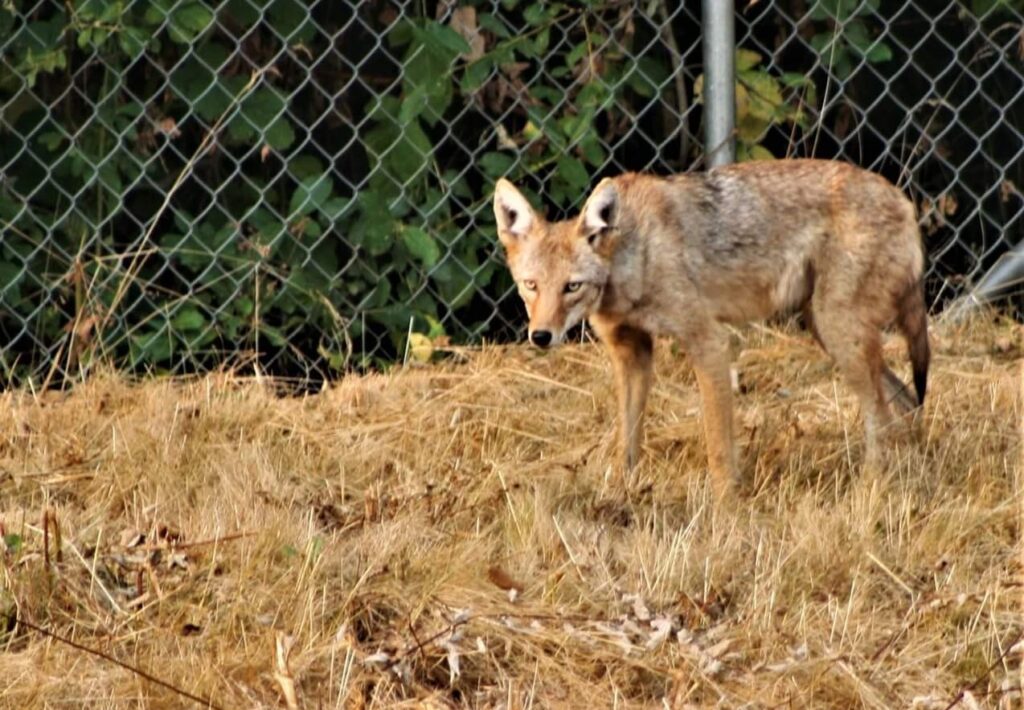 Is It Normal For Coyotes To Come Out During The Day?
Is It Normal For Coyotes To Come Out During The Day?
Are you wondering whether coyotes come out during daylight hours? Well, contrary to what many people believe, coyotes are diurnal by nature, which means they are active during the day.
More and more coyotes are creeping into people’s neighborhoods to search for food, and coyote sightings are frequent, especially during the wintertime. Thus, it is not bad, but it’s perfectly normal to see coyotes come out in the daytime.
However, the nocturnal or crepuscular type of coyotes is active at night, dawn, and dusk). They have altered their circadian rhythm and have more nocturnal habits to evade human conflict whenever they reside in close proximity to humans in cities and urban areas. They will lie in caves, trenches, or rock crevices throughout the day and only come out when it’s dark.
Read on to explore more on the behavior of coyotes.
What Time Do Coyotes Come Out And When Are They Most Active?
Coyotes could be seen at any hour of the day and night. However, they are most active between dawn and sunset. At night, when they engage with other coyotes, you will hear them howl incredibly loud.
As there is less daylight during the winter, they are most active, and this is when most juvenile coyotes depart their parents and seek new homes.
They do not have a predetermined time when they will appear. This period will vary based on the amount of sunlight and the habitat of the coyote. They could emerge significantly earlier at dawn and dusk in regions receiving less daylight. In other areas, they begin appearing in the early evening as the sun starts to set.
Coyotes found in urban spaces tend to have fewer opportunities during the daytime, as they are close to humans. Those that have their habitat in rural areas, however, are highly active throughout the day as the limited human population offers greater hunting opportunities.
When And Where Do Coyotes Sleep?
Unlike most animals, coyotes are unbothered even if it rains while they are asleep. This is, however, dependent on the location and weather conditions at the time of rain.
During summer, they stay in place and do not take shelter. Male coyotes select a bedding site that has proper drainage and is elevated. As defensive cover for their dens, mother coyotes usually prefer shrubs and thick leaves.
Coyotes sleep in dens in urban areas, primarily in parks, golf courses, old building ruins, drainage pipes, and more. These dens are usually ones that other creatures like badgers and skunks have already dug out. They take it over and enlarge it to accommodate themselves inside.
Coyotes love desert climate because of plenty of prey, including snakes, raccoons, rodents, birds, and land for shelter. To outline their territory, they spray urine. The coyotes make burrows in the damp sand and sleep there.
Owing to the hard winter climate, coyotes love sleeping in covered spaces but go out to search for food. Winter is a mating and breeding season for this wildlife, thus, they seem to be more active and conspicuous.
Summer is the coyote’s best season since it provides abundant shelter, food, and hunting potential. During summer, these animals prefer to sleep in open spaces, under direct sunlight, to escape bugs and capitalize on the cooling breezes. As the temperature becomes hotter, they seek shelter in shaded areas.
However, when a coyote sleeps, it moves around a lot, lifting its head to look around before spreading out to sleep again. It constantly evaluates the surroundings for any threat or movements and takes appropriate action.
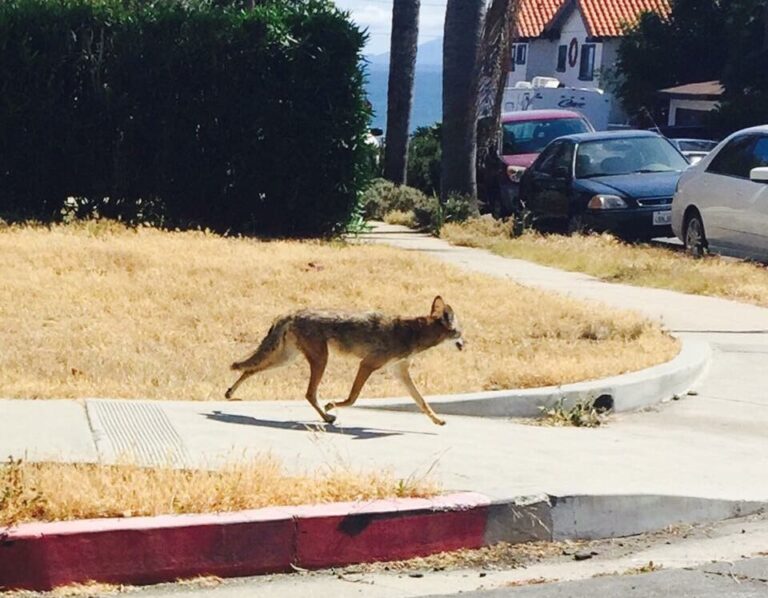
Where Can Coyotes Hide During The Day?
Coyotes hide in covered open areas, raised grounds, or in dens during the day. Dens are most commonly seen in parks and forest areas, shrubbery, preserves, golf courses, and other such regions. These are difficult to come by in urban areas.
These animals also rest in rocky areas and locations where there are fewer humans or predators like wolves throughout the day. They can also use their dens throughout the breeding season. Otherwise, a coyote may rest in a shelter or out in the open during the day.
How Can You Tell If Coyotes Are Nearby?
– Howling
Coyotes tend to announce their presence by howling at night, or sometimes during the day. They howl in packs to alert other groups that their area has been conquered. The same sounds may also aid in their bonding, or, who knows, it may just feel great for them.
Other noises, including barking and whining like a small dog, could also be observed when coyotes are nearby.
– Scats
Like other animals, when coyotes are nearby, they often leave unwelcome gifts behind – feces on the ground. Unlike feces from a dog or another animal, the coyote scats are often filled with hair and bones from their meal. These droppings are usually formed like ropes and are used to establish territorial limits.
– Tracks
You can spot coyote tracks in the muddy terrain as well as dry sand. Although you can easily confuse their tracks with those of a large dog, the coyote strides are relatively longer. What’s more, they move in more direct lines.
– Dead Animals
Lastly, coyotes do not always consume the entire animal. The meal remnants that coyotes leave behind are usually strong evidence of coyote presence. These can include rabbit or rat carcasses, as well as sheep and domestic goats.
Even though coyotes do not usually pose much of a threat to people, it is advised to call a wildlife control professional as soon as you spot a coyote on your property.
Our experienced technicians at Westchester Wildlife will assess your coyote problem, and then quickly and safely trap and remove the animal.
Don’t wait – call our experts for all of your coyote control needs in Westchester, Dutchess, Putnam Counties, NY, and Fairfield County, CT.
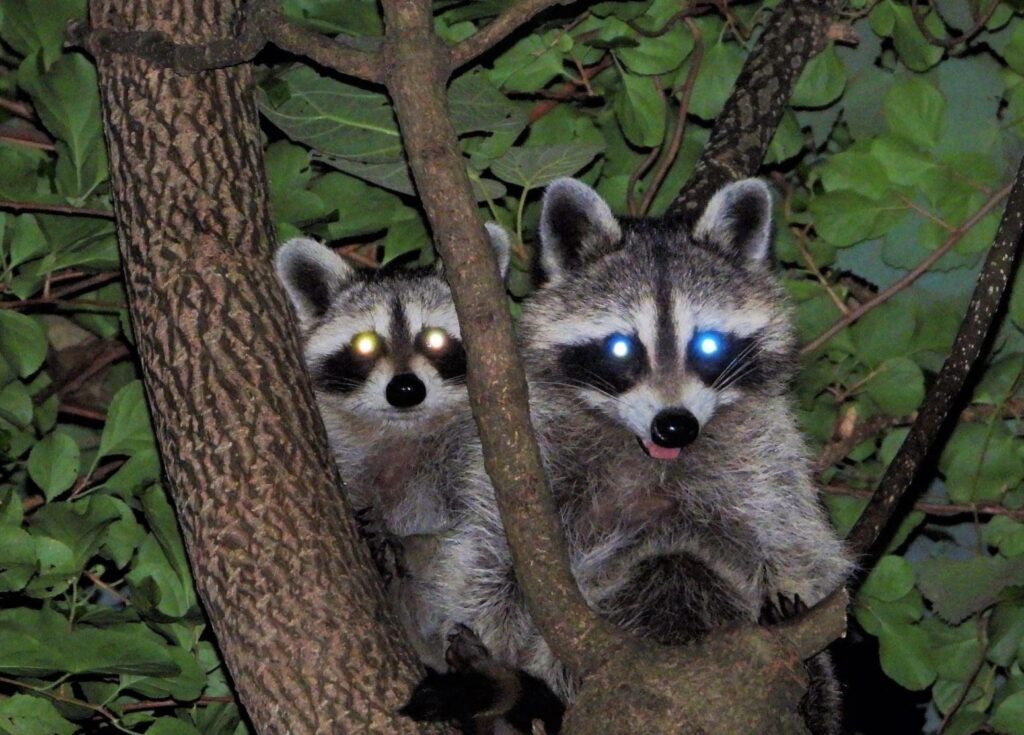 Can Raccoons Live In Trees In Your Yard?
Can Raccoons Live In Trees In Your Yard?
Have you ever noticed scratch marks made by animal claws on the trees in your backyard? Raccoons are most likely the animals responsible for these marks.
They are known for being nocturnal creatures that are active at night, so you might not see one climbing a tree during the day. They might have made your trees their home and only come out to hunt at night.
Can Raccoons Climb Trees? Are They Good Tree Climbers?
Raccoons are very good at climbing and they have many reasons for climbing trees. For instance, a raccoon might climb a tree to rest there for a while and look out for prey simultaneously. The raccoons are able to climb the tree very quickly and are known to be excellent tree climbers.
However, raccoons do not make their long-term homes in the tree branches but are very likely to make a hollow tree trunk their home. As a shelter, the tree trunk will protect the raccoon from predators and harsh weather conditions.
Raccoons have also been known to dig their dens at the base of trees and only occasionally climb the tree to get temporary rest and hunt for prey.
Anytime you notice a raccoon climbing a tree on your property, it is a sign that the raccoon has made a den nearby.
If the raccoon seems to disappear before it reaches the branches, it has its home in the tree trunk. Even if you do not see the animals physically moving up the tree, they are known to leave other signs as they climb, such as scratches and claw marks on the bark of the tree.
Why Do Raccoons Climb Trees At Night?
Being nocturnal creatures, raccoons will spend most of their days resting and sleeping. If your tree bark is not protected, they will climb up at night when they are more active and playful. If they have made their home in the tree trunk, they will come out at night to enjoy nature while hunting for their prey such as rats and other small animals.
If you have bird nests on the trees, the raccoons will climb right up to them and throw away the nests. The raccoons will stay up all night, and this is when they will be climbing the trees more frequently.
These animals also climb the trees to explore their territory and ensure that they are in a place where they can easily access food. Their fingers resemble those of a human, and with them, they can do a lot of tasks.
The raccoons like to climb the trees at night to find a spot that is high up in the tree. While in this spot, they will be able to find food more efficiently. At times, they will climb so high to escape predators and ensure that they can survive the dangerous creatures that roam at night.
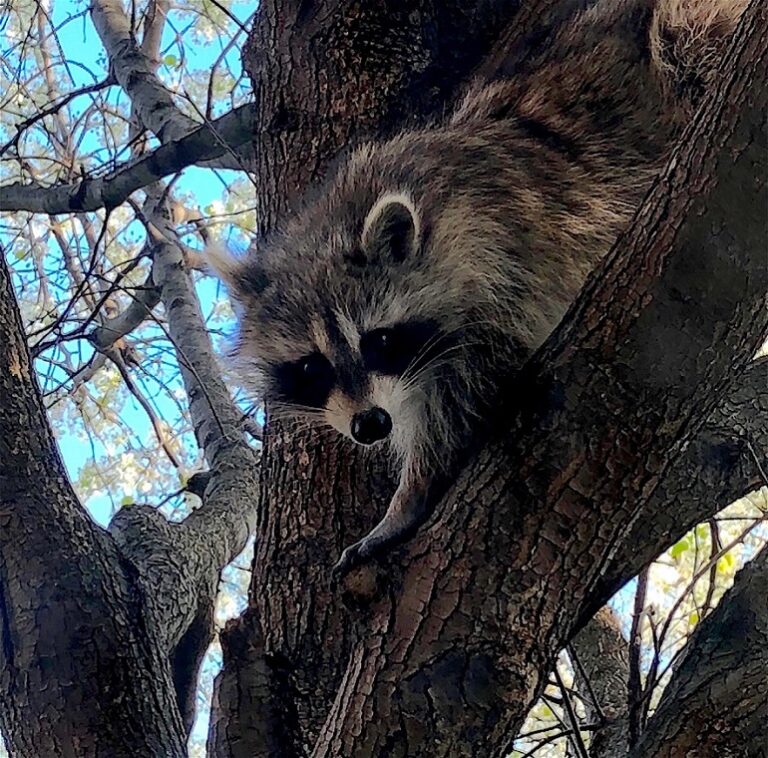
Do Raccoons Sleep In Trees?
Raccoons prefer to stay in places with a source of water nearby and plenty of tree cover. However, they are also adapted to various urban and suburban settings, and you will find evidence of these animals everywhere. During the day, this wildlife will climb the tree to get a safe place to rest and sleep.
The raccoons prefer to sleep in large holes in the trees and the hollow parts of the fallen logs. However, they will stay inside their den when they are not outside hunting, and simply relaxing. Mothers taking care of their young ones will also find a large tree hole far away from predators to ensure that they raise their babies in a safe place.
Apart from the occasional rest, the raccoon will not spend their sleeping time exposed to the outside world since they are adapted to staying in dens. The young ones that have been left in the tree nests will also spend most of their time sleeping.
Do Raccoons Make Nests In Trees?
Raccoons will make their nests just about anywhere they can find a comfortable and safe place to live in. They can make their nests in tree cavities, abandoned burrows, chimneys, barns, and attics.
They have a knack for spotting ideal places to make their homes, and the trees that are already hollowed out are the ideal spot for the raccoons to make their nests. They are skilled and can be able to dig, given their sturdy claws.
As such, nothing can deter them from making their nests in trees which means that they can make their homes anywhere they prefer.
Their habitats are temporary and usually used during the feeding season. Once they are done with feeding the young ones, they will move on to another place and temporarily stay in their dens.
The nests in the trees are some of the best means of defense against predators and the elements. As the raccoons climb the tree, they will leave marks in the bark given their sharp claws.
These animals will quickly make their nests in the trees if it is tall and wide enough to create a nest that’s big enough for them to live in. The mothers that are raising young ones will also prefer the trees as a place to stay safe and bring up their babies in a healthy and conducive environment.
Getting rid of raccoons can be a challenging task as there are numerous factors that contribute to your raccoon problem. If you think you currently have a raccoon problem in or around your property, then you’re in need of a professional wildlife trapper who can eliminate your raccoons.
So call Westchester Wildlife today and let our experienced and highly qualified trappers help with all your raccoon removal needs.
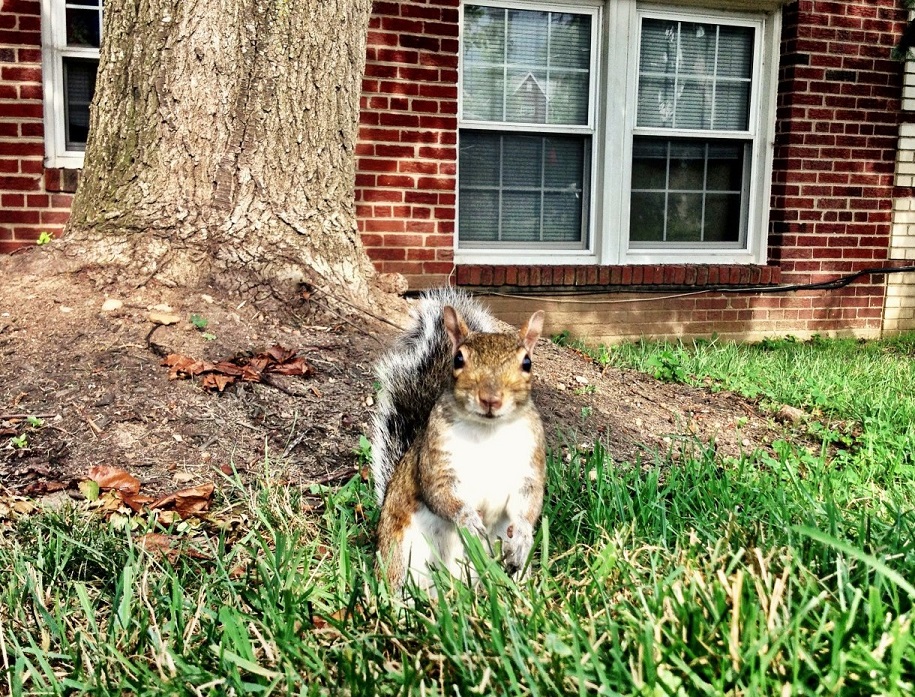 Why Do Squirrels Chew On Roofs?
Why Do Squirrels Chew On Roofs?
Squirrels are a significant rodent nuisance in most states, and the damage they cause can be a costly expense for homeowners. The great news is that it is possible to keep squirrels far away from your roof!
Your roof is a substantial investment that you must safeguard. Whenever squirrels cause damage to your roof due to their chewing, roof repairs are inevitable.
How Do Squirrels Get Into Your Roof?
Squirrels could invade a roof for a variety of reasons. Mating, a surge in predators, a reduction in habitat upon which to establish dens or even cold weather are examples of these.
The following are some of the most typical ways for squirrels to gain access to your roof:
– Roof vents
– Roof edges
– Roof-Soffit crisscrossing
– Gable vents
– Wall vents
– Plumbing mats
– Open, uncapped chimneys
Squirrels On Roof Sounds
Many times you’ll be able to hear squirrels running on your roof, particularly in the evenings and early mornings when they are most active.
Squirrels produce a variety of sounds to match their various actions. Whereas any noise coming from your roof is a telltale sign that a living creature has made its way into your home, learning the kinds of sounds squirrels commonly produce will assist you in identifying if they are to blame. These include:
– Rolling sounds
While they collect acorns, nuts, and other tiny objects, Squirrels tend to make rolling sounds. If they are on your roof, you will most probably hear them sliding these objects all across the flooring of your roof into various spots for safekeeping.
– Scurrying noises
Light dashing and scratching sounds over your roof surface indicate that squirrels on the roof are moving back and forth.
– Squeaking sounds
Squirrels make high-pitched squeaks that are unpleasant to the human ear. Residents could have difficulty sleeping at night if such disturbing sounds reverberate within their walls.
– Rustling sounds
Squirrels are always on the move during the day, building nests, keeping food, and scampering around. This type of activity will produce a lot of shuffling and rustling sounds.
Is It Bad To Have Squirrels In Your Roof? Can They Damage It?
Put simply, these frizzy-tailed creatures might appear adorable from the outside, but their inside is a whole different thing altogether.
They have been observed scratching and gnawing at rooftops, and their razor-like claws and teeth can tear down your roof. They will cut a new hole via the roof shingles or rip through a current one to gain access into your house.
Squirrel teeth are among the hardest of rodents. From polyethylene to the copper sheathing, there isn’t anything that can impede them. Squirrels nibble and eat away at roof shingles to gain access to the decking and underlayment. Defective shingles expose your house to dampness and water damage. Besides, cut roofing tiles provide entry points for water leaks into your home.
Also, the squirrel is likely to chew on roof cables and electrical wiring.
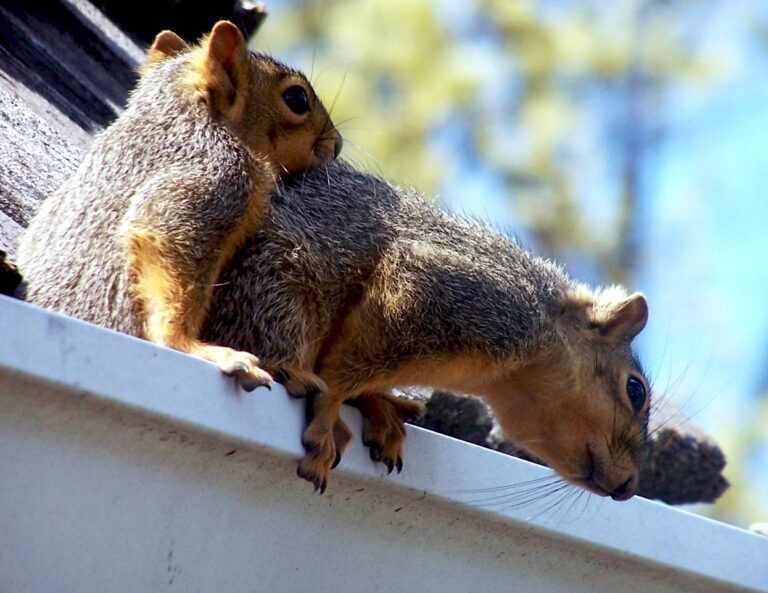
How Can You Keep Squirrels Away From Your Roof?
If you could somehow hear it rustling around and sense the stink of animal urine, you realize you have at minimum one squirrel residing on your roof.
Follow these simple techniques to permanently eliminate squirrels from your roof before they cause significant damage:
– Prune trees surrounding your home
Squirrels can climb trees, and if the trees are close to your roof, they can have easy entry to your house. Trim any trees with branches that droop close to your roof to deter squirrels. Because these rodents could leap rather far, leave at least eight yards of space between your roof and the trees.
– Set up a drip edge
A drip edge is a metal piece that goes beneath your first set of shingles and extends over the edge of your fascia. It is also known as a drip cap because it allows water to run into your downspouts and from the house.
A drip edge is an excellent solution for keeping bothersome squirrels out of your property and off your roof. It renders it harder for a squirrel to burrow between the fascia and shingles on your roof.
Whenever a drip edge is placed, it is coated with a layer of roofing cement and frequently fastened on either end to keep it firm. The good news is that you could get a drip edge fixed without replacing your whole roof.
– Cover any openings on your home’s exterior
Close any loopholes in your house that enable squirrels entry. Keep the siding solid to deter these pests from entering. Construct a chimney cap to prevent them from falling into the chimney.
– Remove any squirrel smells
Even though the previous squirrels have left, their residual stench could prompt new ones. Use an antibacterial fogging agent to wash your roof.
– Provide the squirrels a reason to leave
Perhaps use roof-mounted cage traps to catch all the squirrels or install repeater traps or single-channel exclusion doors on the central exit/entry opening.
You could also buy squirrel repellent and apply it to their refuge. Most sprays incorporate the urine of a predator, such as a fox, and might even prompt the squirrel to flee your roof in a panic.
– Routinely check your roof
Climb your roof several times per year to visually inspect it. Check for ripped insulation, wetness, and animal droppings. If you realize there are missing or defective gutters and shingles, you should have them repaired as soon as possible.
If you hear noises and are under the impression there might be a squirrel running on your roof, give us a call today!
Our exterminators at Westchester Wildlife will do a thorough inspection of your property to determine the severity of the problem and whether there is one squirrel or a family of squirrels that has invaded your home.
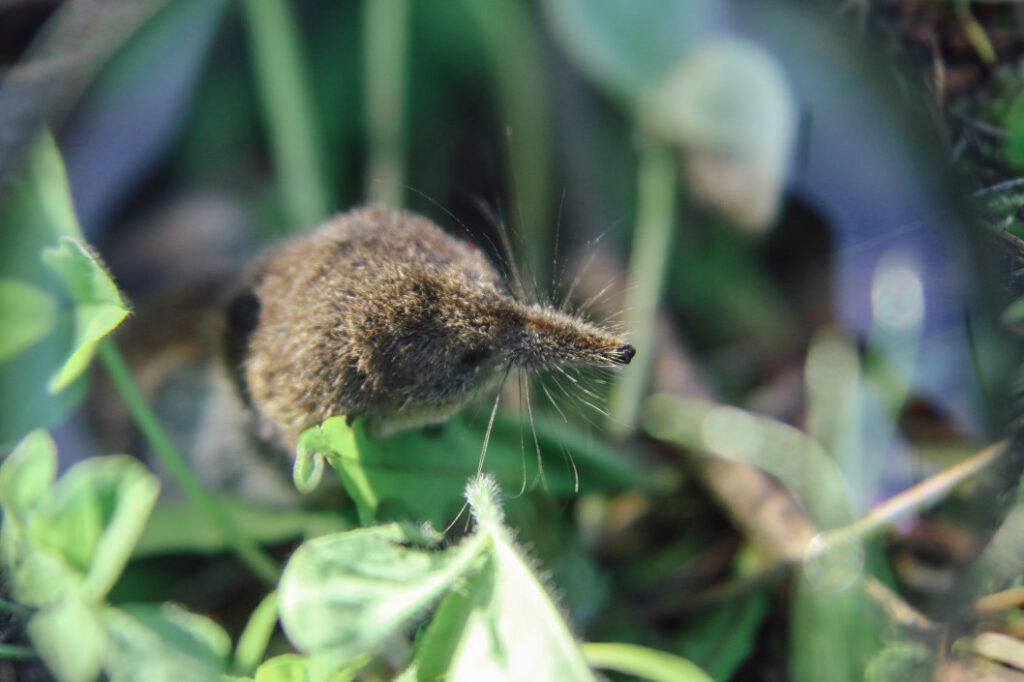 Are Shrews Bad For Your House?
Are Shrews Bad For Your House?
Shrews look like moles or mice due to their small eyes, elongated snout, and dense brown fur. However, they are not rodents as most people think. They are tiny mammals measuring only about 3.5 inches in length.
Despite their small size, they can be bad if they happen to take residence in your house.
Do Shrews Invade Houses?
Even though these tiny aggressive predators rarely invade houses, they still can, and when they do, they cause a big mess.
Shrews are very aggressive predators that can attack your pets. They also have a scent gland that produces an awful stench that makes everyone around uncomfortable.
Additionally, they can also contaminate food and water with their urine and feces. This is dangerous because they may expose you and other house occupants to deadly bacteria and parasites that cause deadly infections.
They also have a venomous bite that they use to subdue their prey. Although their venomous bite is not harmful to humans, their bite is very painful and could take time to heal if the proper medication is not administered.
Shrews have a voracious appetite and one can consume almost twice their body size in one sitting.
They primarily feed on insects but they have also been known to feed on birds, snakes ice, and sometimes, other shrews when an opportunity presents itself. They also feed on seeds, plant bulbs, vegetables, fruits, food remains, and all kinds of flowers. Their voracious appetite and vast diet make them a menace when they invade your home.
Shrews mostly enter a house through holes like the drainage pipes, attic screen, eaves, spaces between windows, and other places in the house where there are gaps.
When they invade your house, they will cause mayhem including emitting a pungent smell that makes the house a very uncomfortable place to live. Although they have very weak eyes, they have an incredible sense of smell and are also very fast and difficult to catch when found in the house.
They are also very aggressive and could bite you if you lack the skill and equipment needed to catch and eliminate them from your house.
Why Do Shrews Come In The House?
Shrews invade homes mainly to seek shelter and find food and water. They normally live outdoors where they forage for food in dense vegetation. However, when food is scarce or if their natural habitat is destroyed by humans or wildfire, they sometimes invade homes.
They mostly come in homes that have birds and pets because presents them an opportunity to find easy food and they can attack and feed on these pets.

How Can You Find Out If You Have Shrews?
When shrews invade your house, it will not take long before you notice their presence as is the case with other pests. This is because of their aggressive nature, voracious appetite, and poor eyesight. In fact, you will notice their presence almost immediately when they invade your house.
However, getting rid of these pests is not easy and requires the help of an expert.
Below are signs that indicate shrews have invaded your home:
Shrew droppings
One of the common signs that indicate that you have a shrew infestation is if you spot their feces in almost every corner of your house.
Shrew feces are about 2mm in diameter and about 6mm long. They are dark in color and corkscrew or curled in shape.
Like the animals themselves, shrew droppings usually have a distinctly unpleasant smell. Therefore, if you notice a pile of droppings in your house with a pungent smell, then that is a sign that shrews have invaded your house.
Unpleasant pungent smell
Another sign of shrew invasion in your house is a pungent smell that does not seem to go away. Shrews have a scent gland that produces an awful stench. They will leave their unpleasant smell in almost every corner of your house, making your home very uncomfortable.
Death or bad injuries on your pets
Shrews feed on birds and other small pets. So, if you notice that your pet is injured or has died and most body parts are missing, then that is a clear sign that shrews have invaded your house.
Shrews are also known to bite large pets such as dogs, causing life-threatening injuries. So, if you have noticed that your pet is suddenly injured and the wound keeps getting worse, then that is a sign that you have shrews in your home.
Family members getting sick
If you or someone in your family suddenly gets sick, then it could be because of food contamination caused by shrews. These pests usually contaminate food and in the process transmit deadly bacteria and parasites that cause illness.
Other signs of shrew invasion in your house include being bitten while sleeping and missing stored food.
Can Shrews Cause Damage To Your House?
In general, shrews do not cause property damage even though they are known to dig holes.
However, they cause other serious damages such as emitting an unpleasant smell, feeding on your pet and any stored food, biting people, and cause illness through food contamination.
If you believe you may have a shrew problem in your house, and need shrew removal and control services, feel free to give us a call.
Westchester Wildlife provides professional shrew trapping and removal services in Westchester, Dutchess, and Putnam Counties, NY, as well as in Fairfield County, CT.
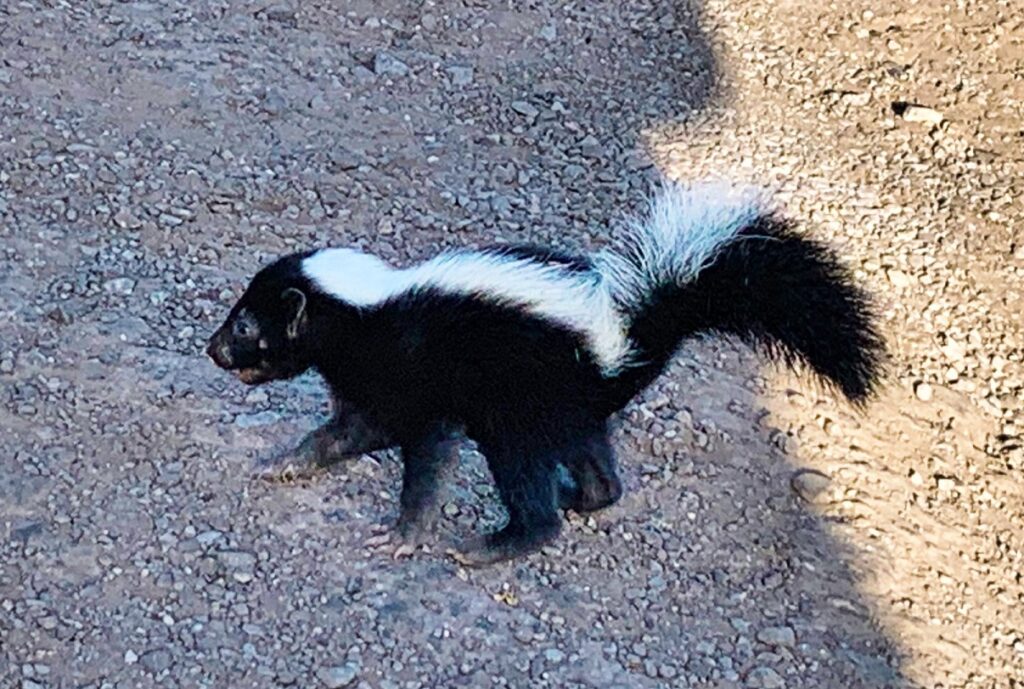 What Attracts Skunks To Your Yard At Night?
What Attracts Skunks To Your Yard At Night?
Keeping skunks away from your yard and home may feel like a daunting task. Thus, you need to figure out the things that could be attracting them to your yard at night in the first place.
Some of the things that can draw skunks to your property include food sources in your birdseed or feeder and garbage. In addition, these animals feed on earthworms, grubs, and other larvae that they may easily find in your yard’s soil during nightime. Also, they are always looking for an opportunity to dig under porches and crawl spaces.
Read on to learn more about skunk infestation and how to keep them from your yard.
Will Skunks Dig Holes In Your Yard At Night?
You are most likely spending a lot of time trying to make your yard look attractive. So it can be disappointing when you wake up and see unsightly holes in it. If you’ve experienced this, you might be wondering what’s digging your lawn.
Well, skunks are one of those wild animals that can dig holes in the yard at night.
Typically, these holes are shallow and have loosened soil. Skunks mainly dig in the ground to look for food or shelter. If you see huge grass chunks that look like they’ve been pulled from the dirt, it could be as a result of skunks eating grubs found underneath the ground.
These animals pull the grass to try and access the grubs that are on the dirt’s top layer. If there are many skunks in your yard, they could tear a huge portion over a single night to access grubs and other insects in the ground.
However, note that digging isn’t the only issue these animals cause. They can also damage your plants as they burrow looking for food. Plus, skunks can spray pets or people in the yard, causing a huge mess. Again, they might be carrying diseases, which could spread to the house occupants.
What Are Skunks Eating In Your Lawn?
Skunks dig the ground to feed on larvae of hornworms, cutworms, Japanese beetles, and other insects in the crops.
But, apart from insects, they also eat small games grasses, grains, leaves, garbage, and any fruit that they can reach.
Also, they can eat sweet corn but only the lower ears. So planting tall corn varieties could control this problem.
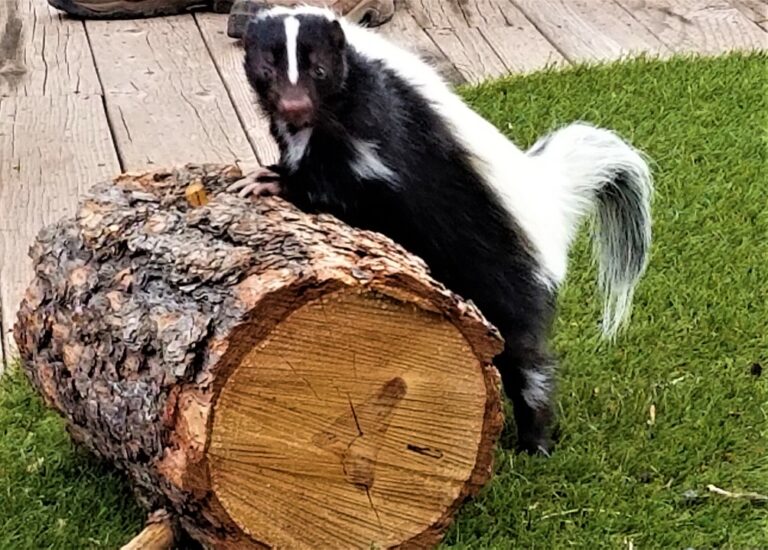
What Does It Look Like When A Skunk Digs In The Yard?
In fact, skunks are not the only animals that dig holes in the yard. Raccoons and rabbits are culprits too. So you need to identify the animal that’s doing the damage first before thinking of a prevention measure.
Skunks dig two holes, small holes they use to find food, and burrows they sleep and nest in. It’s usually advisable that you wait for a wildlife removal professional to tell you about the animal on your property rather than risking getting too close to the animal as it can defend itself.
But, there are some ways you can tell whether or not it’s a skunk’s burrow.
One is the size and location. Skunks will have a burrow entrance of about 8 inches wide and it’ll be so deep that you may not be able to see the nest.
Also, these animals mostly dig their holes under a sound and protective object. So you’ll mostly see holes on a large rock or fallen log which could be an outdoor structure like patio, deck, etc. in your yard.
Besides, look for the hair on the entrance. Skunks leave only a few hairs compared to raccoons.
What Does Skunk Lawn Damage Look Like?
Skunks have a stronger sense of smell than humans. They usually walk on the lawn with their noses close to the ground. Once they smell some grubs, they tear up that lawn apart and pull chunks of turf to search for food.
If you see small circular holes about 3 to 5 inches with loosened soil, you might be having a skunk problem.
How Do You Fix A Skunk Damaged Lawn?
In general, it can be hard to push back the pulled turf. And the animals might come back to check whether they exhausted the grubs.
However, you can try smoothing the destroyed area and overseed it. Additionally, make sure that you water the area as it can help the grass to regrow. You can also try to apply insecticide to the damaged areas, although this isn’t a quick-fix method.
How To Keep Skunks From Digging Up Your Lawn And Out Of Your Yard At Night?
The first thing is to make sure that you have a skunk problem. And this you can tell from the unpleasant smell that skunks release. Then use these tips:
Buy Sensor Lights
Skunks can’t stand bright lights as they are nocturnal. Therefore, installing a motion sensor light can help keep them away from your garden. This device startles most animals, and it is effective.
However, note that this isn’t a long-term solution. Eventually, skunks will realize that these lights cannot do anything.
Invest In A Scarecrow
Skunks fear people. So they’ll likely be terrified by a mechanical scarecrow. There are different scarecrows to choose from, including those that look like people or predators such as owls or wolves.
Use Household Scents
Skunks do not like strong scents like those of citrus, soap, or paprika. Spread them around your yard to keep this wildlife away. You can also try stronger odors like detergents and the smell of mothballs.
Spray Predator Urine
Dog or coyote urine can help keep skunks from your lawn. You can spray it around your yard’s perimeter or purchase flakes dipped in coyote urine at the garden store.
Compost With Caution
Composting is good for the environment but it can attract skunks and other wild animals. So avoid putting fish, meat, or other tempting sources in the compost bin. Also, ensure that your garbage bins are properly sealed.
Remove Grubs From Grass
Skunks dig in yards trying to look for food. Since most yards have grubs, it’s no wonder many have skunks visiting them. Apply nematodes that eat grubs on your lawn. You can buy them from garden stores and apply during early spring or late summer.
However, if you need the help of an expert, call Westchester Wildlife today! We will effectively, safely, and humanely trap and remove nuisance skunks from your yard where they are not wanted!
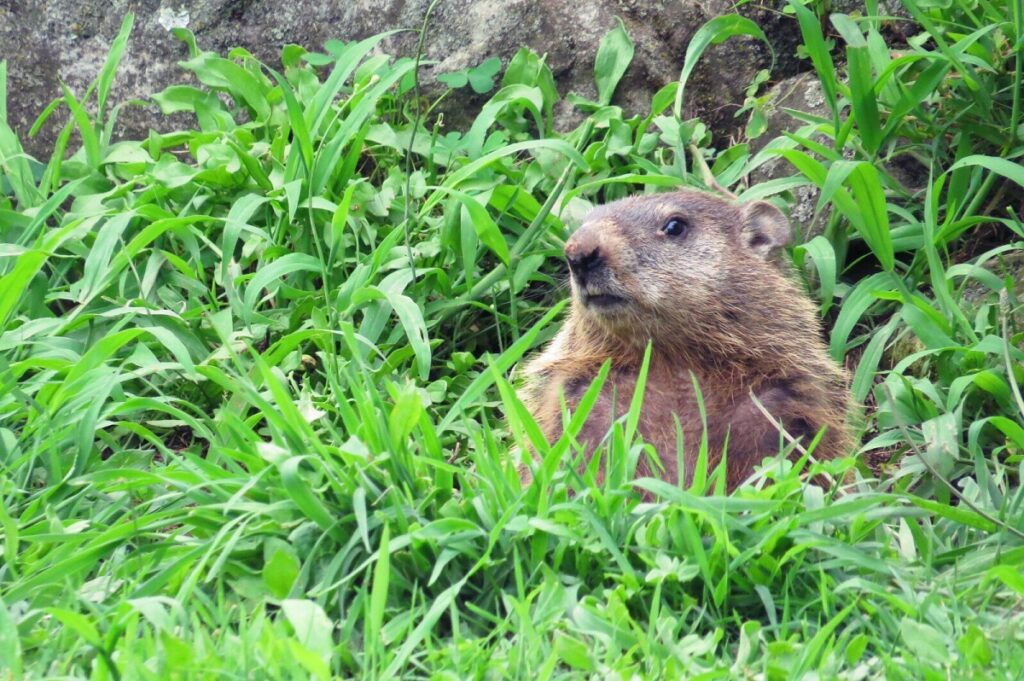 Is It Bad To Have A Groundhog In Your Yard?
Is It Bad To Have A Groundhog In Your Yard?
Have you just spotted a groundhog in your yard and wondering if you should worry? The short answer is YES, you should.
Groundhogs, also known as woodchucks, are aggressive animals that are hard to get rid of when they invade your property. These rodents usually dig burrows in grassy areas and eat through gardens causing a lot of damage.
They can also cause serious structural damage through burrowing. In addition, they carry ticks and fleas which can pass diseases like Powassan and Lyme to pets and humans.
Once they invade your yard, it can be really hard to eliminate them on your own because they are very aggressive. Thus, it is always the best option to contact an experienced pest and wildlife specialist who’s got the tools and knowledge to deal with your groundhog problem.
How Do You Tell If You Have A Groundhog Active In Your Yard?
Common signs of damage that indicate groundhogs are active in your yard include:
– Raised ridges crisscrossing your yard will be easily visible
– You will notice raised, multiple mounds of dirt in your yard. These mounds resemble volcano-like swellings and are the entrance and exit of groundhog holes in the ground
– If you spot areas in your yard that feel squishy or the soil is very loose
– If you realize that some areas in your yard have dead or discolored grass that follows a specific path
Other damages that groundhogs are likely to cause include damage to the grass, tearing of tree roots, and flower bed damage. These damages will make your yard look unsightly!
What Attracts Groundhogs To The Yard?
As expected, the main thing that attracts groundhogs to your yard is food. These animals are herbivores and mainly feed on plant matter.
Their favorite foods are alfalfa and clover but they feed nearly on any plants such as grass; weeds; dandelion greens; herbs; fruits like strawberries or blueberries; vegetables like cucumber, green beans, corn, or lettuce.
Groundhogs feed a lot to gain enough weight that will sustain them during hibernation. Therefore, when they invade, they will eat anything that they come across in order to gain enough weight that will sustain them during the winter season, and in the process, they will leave a lot of damage. That is why you need to be worried when you spot them in your backyard.
Groundhogs can also skillfully climb trees, fences, and walls. They will climb mainly to escape predators and in search of food. Find out how to prevent them from damaging your yard and keep them out for good!
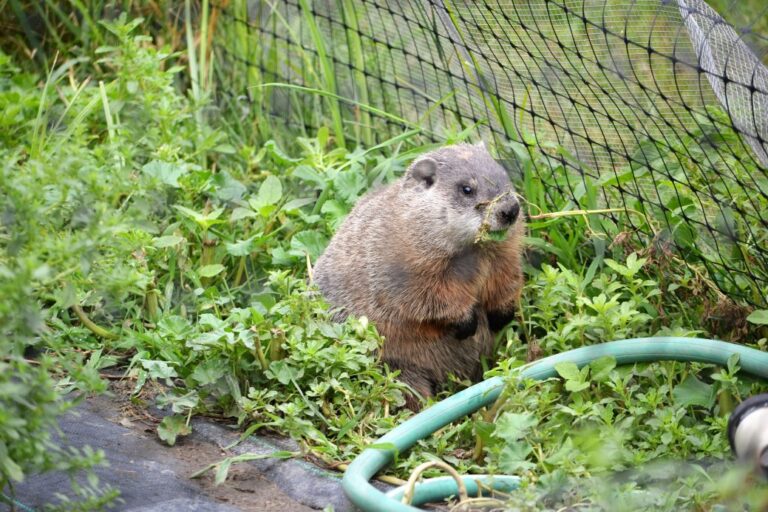
How Do Groundhogs Dig Holes In The Ground?
Groundhogs spend most of their time in underground burrows which can be as long as 6 feet deep. These underground burrows usually have dozens of entrances and exits. That is why it is very difficult to trap a groundhog if you lack the necessary knowledge and experience.
When digging inward for several feet, they incline the tunnel upward for a few feet. They will then proceed to dig horizontally for 15-25 feet to prevent the tunnel from flooding in case it rains.
Groundhogs are very clean animals. From their main tunnel, they usually dig another tunnel just a few feet apart, which is exclusively used as a latrine. Once one latrine is full, they usually seal it off and dig another latrine elsewhere.
The main burrow is used for raising children, sleeping, and hiding.
What Month Do Groundhogs Come Out?
Groundhogs are typically most active during early spring. This is because the weather is usually ideal for them during this time.
During the warmer spring and summer months, they spend most of their time sheltering in their cool burrows and only come out to feed in the early morning and evening when temperatures have dropped.
They usually start to hibernate from mid-October all the way to February. By the time they start hibernating, they need to have gained a minimum weight of seven pounds in order to survive.
Are Groundhogs Aggressive To Humans?
It is very rare for groundhogs to attack humans. However, when they feel threatened or when they feel that their babies are in danger, they may attack.
A few cases of groundhogs attacking humans have been reported but injuries are not that serious. However, in some cases, the injury can be fatal, especially if they carry rabies.
Due to the damage they cause, it’s important to remove groundhogs from your property as soon as you notice any signs of their activity. Contact Westchester Wildlife today and let us help rid you of groundhog problems efficiently and safely.
Our team of licensed technicians has the skills and tools necessary to carry out a humane wildlife control and removal from your property. Our humane groundhog removal services are the best way to keep your home safe from the potentially destructive actions of these wild animals.
So don’t wait until woodchucks have completely ruined your lawn to seek help. Trust our team of experts at Westchester Wildlife for all of your groundhog removal and control needs by calling now!
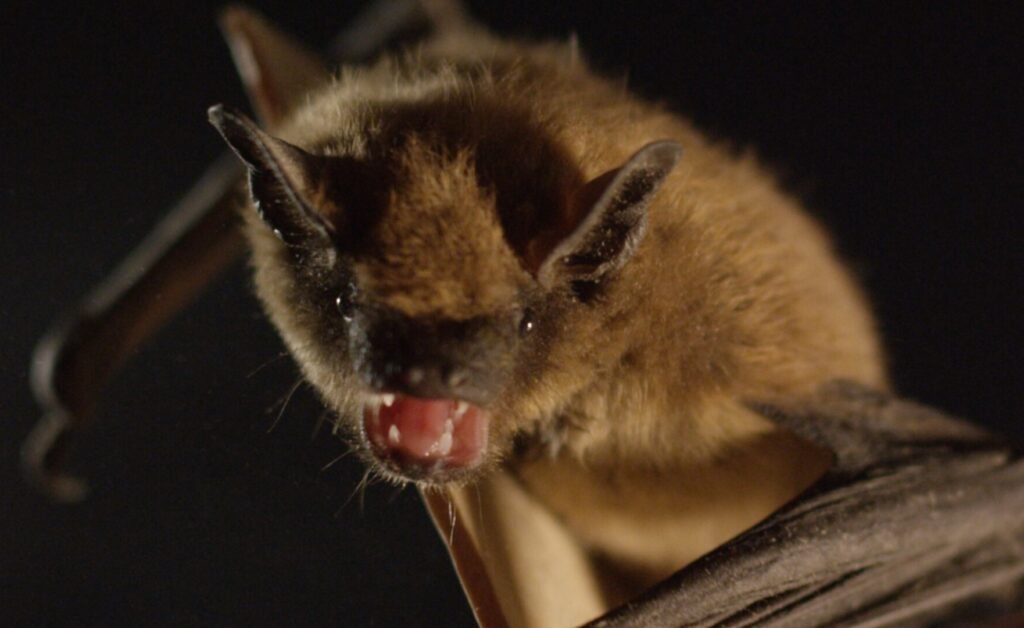 Is It OK To Leave Bats Living In Your Attic?
Is It OK To Leave Bats Living In Your Attic?
Bats can be excellent neighbors when they keep a proper distance from your home. Other than acting as natural mosquito repellants, they promote pollination and aid in seed dispersal.
While bats don’t always live indoors, some situations force them to seek shelter, for example when they feel endangered or a female has just given birth.
If they are next to your house and find an opening in the attic, you can be sure they will seek shelter there.
Another reason that attracts bats to a home is the presence of insects like mosquitoes and moths around the lights. If the insects are always present, they may choose to find a nesting site close to the source of food or water, and your attic is a perfect spot!
Can You Let Bats Live In Your Attic Or Should You Remove Them?
When you have bats in attic, you might be tempted to let them stay because they help remove all kinds of bugs from your property. After all, they can eat up thousands of insects every evening, so you won’t have to worry about bugs anymore.
But while they are helpful, they can be a nuisance once they stay in your attic. For instance, they can cause infestations, make a lot of noise, and cause significant damages to your structure.
How Long Can a Bat Live In The Attic?
The average lifespan on a bat is between 10 to 20 years, but survival into adulthood is mainly determined by the quantity of food and the kind of shelter that’s available. If a bat manages to get food and good shelter, the animal will live long.
Your attic is one of the best forms of shelter a bat can get as it can get insects or rodents around the compound, if not in the house. Besides, most people don’t spend much time in the attic, so these mammals will be free to enjoy their stay almost uninterrupted.
Since the bats have everything they need in the attic, they can stay and reproduce more to make a large colony. In fact, they’ll live for generations if nothing is done, so don’t assume they will vacate willingly. Instead, be proactive and find a way to get rid of these animals as soon as you can.
Can Bats Damage Your Attic?
Compared to all pests and wild animals that can stay in attics, bats happen to be one of the worst.
One main thing they do is damage the property, particularly the electrical system, plumbing, and other similar fixtures. They also claw away the insulation, wood, and other similar building materials and leave behind rub marks from their body oil.
Even their feces can cause significant damages to the insulation and wooden building materials. The feces smell is also pretty bad and will permeate via the walls and spread throughout the house.
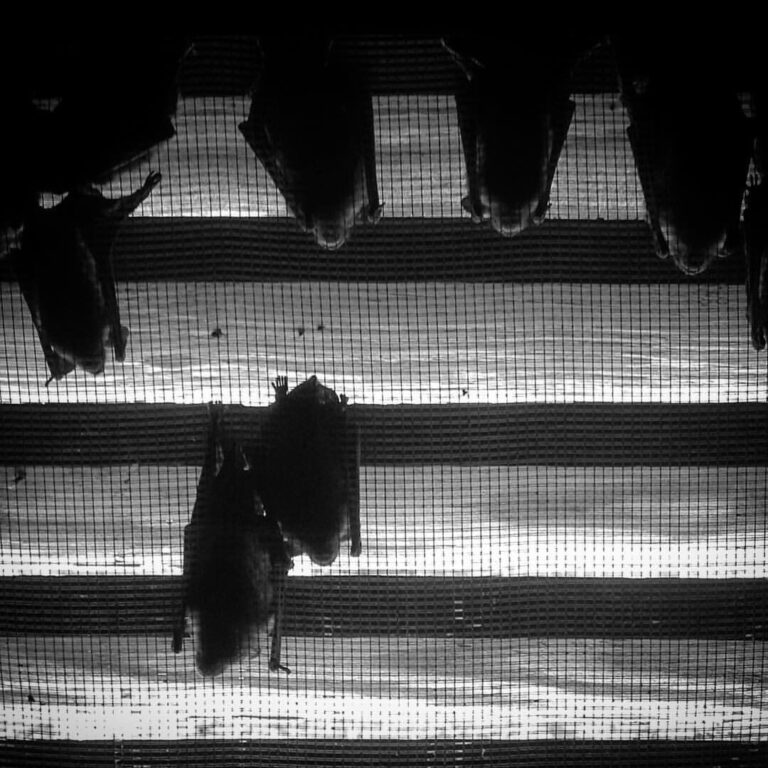
Can You Get Sick From Bats In Attic?
Other than damaging your attic and making a lot of noise, bats can make you get sick.
Their droppings, guano, contain a fungus known as Histoplasma capsulatum which is detrimental to people’s health. When the guano dries and becomes an airborne pollutant, it can be inhaled, and the fungus will cause a lung infection known as Histoplasmosis. The infection can spread beyond the lungs to the entire body, which is fatal. You shouldn’t even attempt to clean bat guano on your own!
These pests also expose humans to rabies. This often occurs when someone is bitten by an infected bat or comes into contact with guano, fur, urine, or blood from the bat.
When Do Bats Leave The Attic?
Once bats set up shop in the attic, they can stay for a long time if you don’t know their way of life. Mostly, female bats and their pups are ready to leave the attic to hibernate in the nearby caves right before winter. This is because the cold weather drives pests and insects away, and they only emerge from hibernation after the cold season.
Other bats opt to migrate to warmer areas instead of hibernating. This is the best time to rid yourself of the bats in attic. You should call professionals like Westchester Wildlife company who will determine the holes the animals used to gain entry or leave your attic and then seal them.
What Time Of Year Is It Legal To Remove Bats From Attic?
Since bats are an endangered species, they get protection from state and federal laws. This is the reason why you cannot get rid of them whenever you want even if they are a nuisance or causing damage to your home.
However, it is legal to remove bats from your home around mid-August to mid-October. Most pups can fly by July, so by mid-August, the bats leave their nursery site to find an ideal place to hibernate during winter.
Consequently, get experts to remove the bats and seal the openings within this time because when they hibernate in your attic, you will not be allowed to bother them until the next bat removal season.
If you have a bat problem in Westchester, Dutchess, or Putnam Counties, NY, and Fairfield County, CT, we can help. We specialize in the field of bat removal and bat pest control in the attic. So give us a call today!
Where Do Sparrows Nest In Homes?
House sparrows have long been associated with people. These pest birds have chosen to live near human dwellings and take advantage of this close association. As a result, they can wreak havoc on your property, and your sanity!
Sparrows prefer to nest in covered spaces, mostly in residential buildings, although they frequent barns and outhouses as well.
They build their nests using a variety of materials such as wool, hair, or man-made products, but grass or straw is always their favorite. Occasionally, they utilize nests abandoned by other birds.
In this article, we will discuss all the places that sparrows like to nest in your home. So keep reading to learn more!
Common Places Where House Sparrows Can Be Nesting
IN ROOF SPACES
They have a bad reputation for nesting in roof spaces where they gain access through cavities under the eaves. The gaps allow the sparrows to be able to get in and out as they please.
If the roof on your house has clay or concrete tiles, sparrows usually build their nests under the tiles, at the edges of the roof, and above the fascia boards.
When the birds push their nest materials under the overhanging barrel-shaped tiles, they will dislodge these tiles and cause them to fall crashing down.
In addition, loose, missing, or cracked tiles can soon become potential sites for sparrow nests, and harmless looking debris or dirt will only help fuel the problem.
Besides nesting in the eaves, in rafters, and underneath the roof shingles, house sparrows tend to make their nests in soffits. These spots are perfect for roosting as they provide cover to stay away from predators and good shelter from the elements.
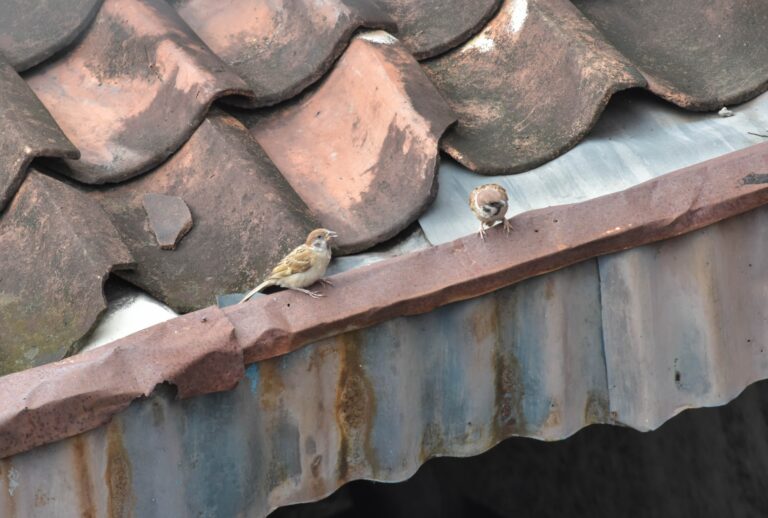
UNDER AWNINGS
Sparrows can build nests on or under your patio awnings as they are easy to rest on.
There are many methods you can use to stop these birds from nesting under your awning. Using bird netting is excellent for keeping sparrows away and prevent them from making a nest in the awnings. And even if they come too close to the net, they will not become trapped in it.
IN CHIMNEY
Just like the roof and awnings, a chimney is ideal to set up a home due to the great deal of protection and warmth that it provides.
There is only one way that birds get into the chimney, namely through the upper portion of the chimney.
However, it often happens that the birds nesting on top of the chimney wander inside or slip off the edge. And that leaves them unable to fly up again to escape. There is not enough space to spread wings, nor can they fly vertically.
Sadly, birds can be difficult to get out of the chimney.
IN ATTIC
House sparrows in the attic are a common problem as they will build nests and lay eggs happily in such a warm, secluded place.
A high place like the attic is easy to take flight and stay close to food sources. Nests in attics are usually located 8 to 30 feet off the ground, which allows sparrows to hide from predators.
Damaged roofs and small openings near the top of a house such as attic vents, could allow birds into your home. Since sparrows are little creatures, they can fit easily through crevices in the roof, walls, and windows as tiny as 3/4 of an inch.
INSIDE WALL CREVICES
Sparrows are also notorious for sneaking into various openings in structures and making their nests in the crevices of walls. Once some of them have found a site they enjoy, sparrows will then begin to swarm the place in large numbers.
Thus, it’s important to inspect your walls for cracks, holes, and crevices that may serve as entrance points for these birds.
And if you notice that the exterior walls are stained with bird droppings, that’s a clear sign that sparrows are making themselves at home, in your home!
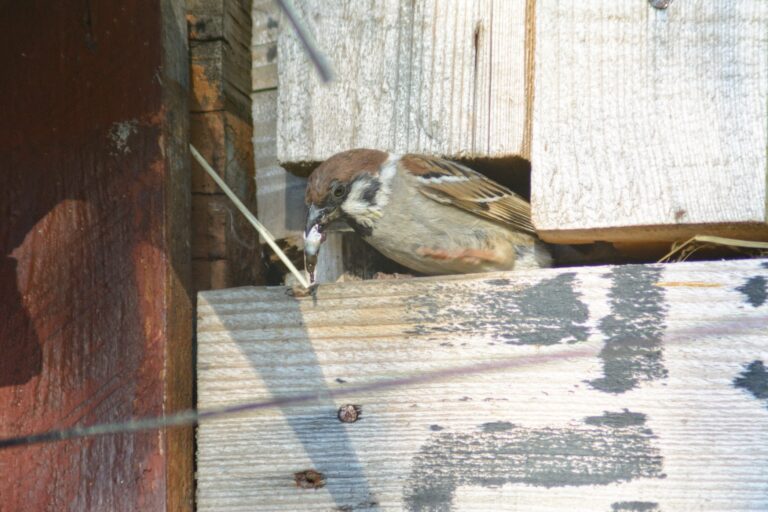
IN VENTS
Dryer vents, attic vents, as well as openings found on the home’s exterior walls from bathroom and kitchen exhaust fans, provide excellent nesting locations. Since the vents are quite small (typically 3 or 4 inches in diameter), sparrows find them ideal to stuff their nesting materials into them.
Vent openings usually have plastic or aluminum covers that stop drafts from getting in. But these covers are nothing but just flaps or louvers that open easily to allow air to escape. The sparrows have learned to manipulate them effortlessly.
Feces and urine inside the vents can create a strong odor throughout your home.
IN GUTTERS
House sparrows might also decide to nest in your gutters. When a bird builds its nest in the rain gutter, it becomes a mess as there is a lot of debris and droppings left around.
This will eventually block the flow of water, which may present a fire hazard at some point. So this is why it’s very important to stop sparrows from nesting in the gutter.
IN TREES
Open tree branches or enclosed cavities in a tree are ideal places for the birds to nest in. And sparrows will indeed choose them when other sites such as holes in building walls, vents, birdhouses, and more, are scarce.
On a Final Note,
Your house structure can provide sparrows with a great substitute for a tree hollow. Thus, you need to act as soon as you see a telltale sign of them settling in so that you don’t let these little cute birds become a big pest problem in the future.
Here at Westchester Wildlife, our specialists have all the tools and knowledge to discourage sparrows from choosing your home to nest in. So contact us today and have our trained technicians deal with your pest bird problem safely and humanely.
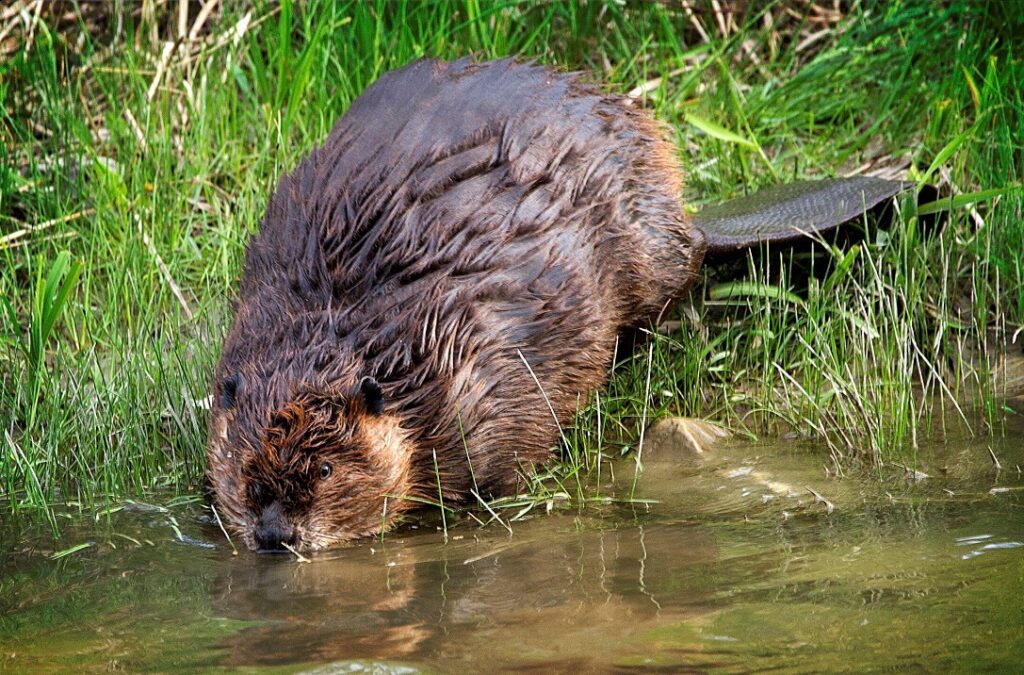 Do Beavers Eat Wood In Your Backyard?
Do Beavers Eat Wood In Your Backyard?
Everyone’s heard about the woodchuck chucking wood, but what about the beaver that eats wood? Could this be happening in your backyard these days, without you even knowing?
First, let’s discuss how beavers eat. The large front teeth, called incisors, that you see on the outside of the closed mouth of a beaver actually mean they are eating something most of the time.
Just like a human, a beaver tends to eat with its mouth closed. It just has a nasty overbite that it sometimes uses to peel off bark to eat much like a human unwrapping a candy with their own fingers.
Do Beavers Really Eat Wood?
The truth is, beavers do not eat the wood or the whole tree but rather the cambium layer – the inner bark off of the tree which they just chew and then spit it out.
After that the wood is taken to form a dam or a lodge for them to live in on the water of a river. It makes for a much lighter outward style of housing, even without the need for painting as it would be in the case of humans.
Beavers have also been known to eat the softer wood just underneath the bark of the tree at times.
Mostly though, they just eat leaves and aquatic plants that can be found just outside of their new woody homes.
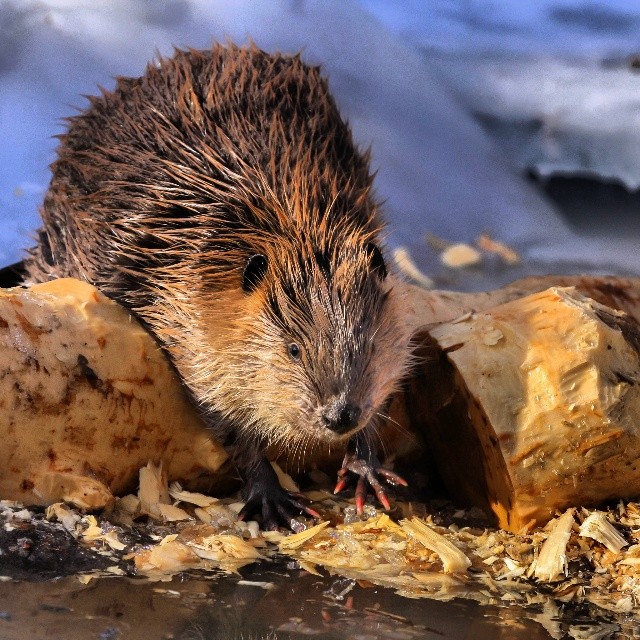
What Type Of Trees Do Beavers Eat And Not Eat?
What about the kind of trees beavers consume the bark of and use for housing? No beaver will enter your yard if you don’t have the right trees, after all!
Conifer trees are only eaten by beavers if every other food source is scarce in the area. However, they love willows, so you may want to consider a small indoor container willow tree rather than a live one outside.
Do Beavers Eat The Whole Tree And How Long Does It Take a Beaver To Chop Down a Tree?
Also, people can sometimes get very confused about whether or not beavers use the entire tree for eating and the building of their homes, and how long this can take. After all, you’d rather have a tree fully removed from your home than simply leave a dead stump or having to look outside and see a half-eaten tree in your yard for a week, right?
If you consider an eight-foot tree to be the average in your yard, then you’ve gotta look out! The “busy beaver” concept is most true at night in this instance, where only five minutes is needed for a beaver to do enough chewing with its incisors to fell a single eight-foot tree.
Knowing that beavers often live with their families means they could chop down half your yard in that time if they all worked together. Imagine the nightmare that replanting all those trees would be!
These rodents do find a use for the whole tree as well. Of course, as stated previously, the tree itself is used for food at the time, but the branches are widdled down a bit at the ends and stacked together for the use of lodgings.
That means every part of the tree they cut down is primed for use. Even though they do leave a stump behind as a calling card for you in the morning, and that would be an unfortunate truth you’d have to deal with.
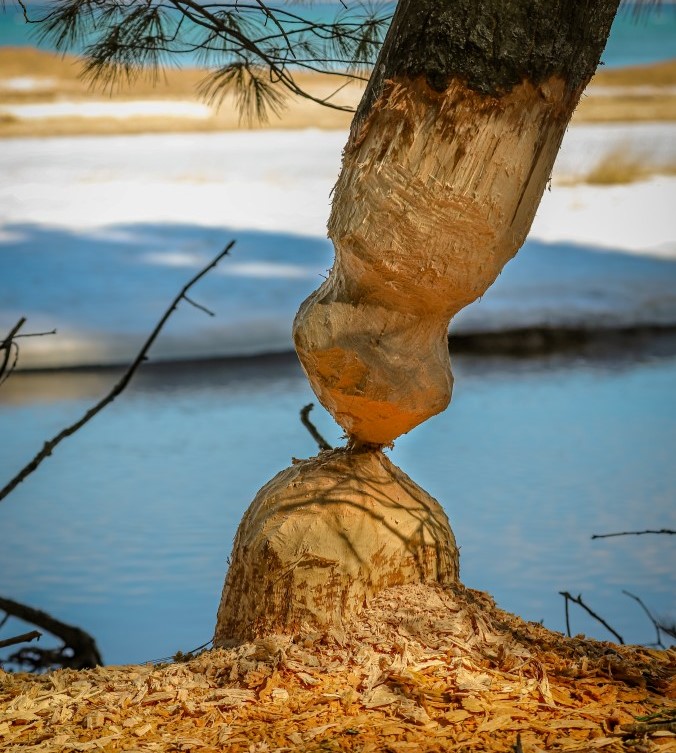
What Size Tree Can a Beaver Cut Down?
But going on the higher end of the spectrum, how tall of a tree can a single beaver cut down? And how much wood can the most eager beaver consume at once? Or will there be a log sitting next to your stump that the beaver just couldn’t finish gnawing on before you got up in the morning?
A tree as wide as 33 inches around, that’s 3 whole feet, can be eaten through by a beaver for use in their dams and lodgings. These animals usually prefer the smaller trees though, no matter how tall, at a 2 to 6 inch diameter. That means that your big, very old trees will most likely remain safe, while your new, small trees are the ones to look out for.
But this also means how tall your tree is doesn’t matter to the busy beaver. It could be 3 feet tall or 30, the beaver only has to chew the bottom off of it and you’ll have a problem anyway.
How Much Wood Can a Beaver Eat?
As it turns out, beavers actually only eat about 1.4 to 1.5 pounds of wood per day. That means, unfortunately, you will find logs sitting around at riverbanks or next to your wildlife pond that the beavers choose to live in.
Luckily, the beavers will move your log free of charge so they have ready access to the top of the chopped tree for building their homes as well as having an abundant supply of food for a few days or maybe even over a week.
This would explain why only one tree seems to be needed by a beaver at a time, at least before it starts a family.
Beavers are known to be very hard-working animals, but surely you don’t want them working hard on your property. It’s important to eliminate these critters as they can cause a massive amount of damage, fast! Besides cutting down the trees in your backyard, the dams they build can cause flooding that will destroy your landscaping.
Westchester wildlife offers professional beaver removal services for New York and Connecticut. Our beaver control experts will humanely remove these rodents and ensure they don’t return to your property. So if you are having problems with beavers, don’t hesitate to contact us today.
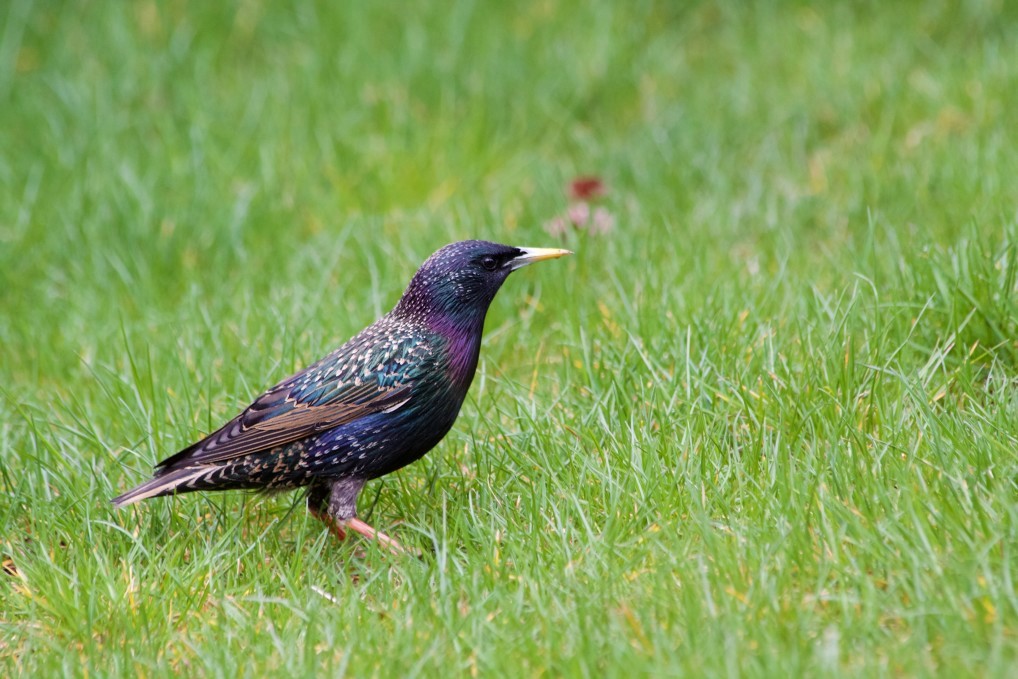 Are Starlings Bad For Your Lawn?
Are Starlings Bad For Your Lawn?
European starlings are considered one of the most common nuisance and invasive bird species found throughout the United States.
No matter which area you live in, whether it’s a rural or urban area, starlings can be a real problem for residential as well as for commercial properties. Starlings can be a nuisance due to their nesting, eating, and roosting habits.
These purplish-green birds with yellow beaks and white spots are quite pretty to look at, however, they are despised by lawn owners, ecologists, and bird watchers alike. Starlings are loud, talkative, annoying, very aggressive, and they are just about everywhere!
They can be a pain to clean up after, not to mention the damage caused to your house and the appearance of your lawn.
Why Are Starlings Bad For Your Lawn And Yard?
When European starlings are in the flocking phase and congregate in large numbers, they can become a nuisance. Thousands of them will overwhelm structures, trees, and lawns. Starlings roosting in urban locations can cause health concerns, waste contaminated ground, odors, and noises.
Their droppings are hazardous and can spread diseases to humans and pets. When walking on the lawn, you or your dog can accidentally bring the bird waste into the home.
Dried droppings release dust that can cause bad health issues such as Histoplasmosis (fungal respiratory disease), or other illnesses particularly in those suffering from asthma. Bacteria and parasites in the bird droppings also pose a health risk.
If many starlings are foraging around your yard, they might bring in pests as these birds often carry ticks and mites, or other parasites. The pests can then transfer to people and their pets.
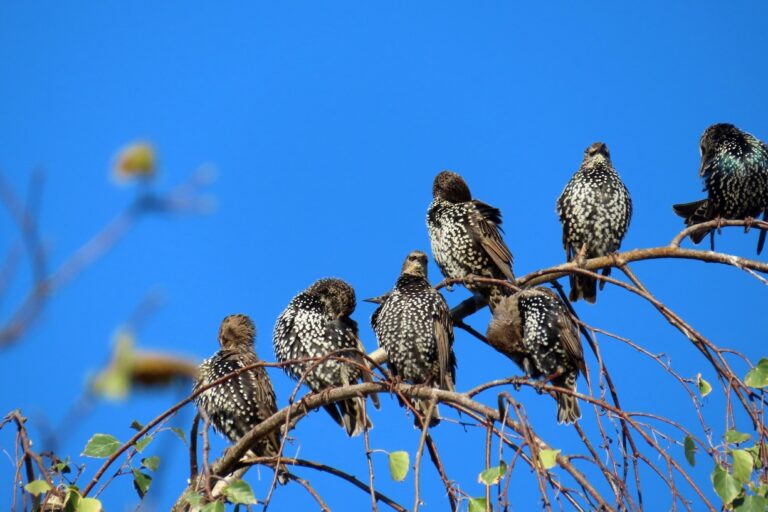
Do Starlings Damage Lawns?
Starlings can damage grass turf as they search for food. The root systems of the grass might be torn due to pulled roots while the birds are looking for worms.
Large flocks can destroy crops in your garden and disturb your newly seeded lawn when the birds feed on seeds and berries.
Also, their waste can possibly spread invasive weed seeds around your yard.
On the other hand, starlings can also be beneficial to your lawn.
Homeowners usually complain about starlings settling in numbers onto lawns. But these birds are actually helping the lawn by eating harmful pests, and thus, acting as a natural form of pest control.
Starlings love to eat leatherjacket bugs, which are the larvae of crane flies or daddy long legs. Leatherjackets are considered a pest as they damage crops, eat plant roots, and make the lawn look unsightly. So, the more starlings in your yard, the better off your lawn will be in terms of pest control.
In addition to getting rid of destructive pests, starlings will also naturally aerate the soil while poking holes in your lawn.
Why Do Starlings Peck Your Lawn?
Starlings are mostly ground foragers that feed on a variety of critters living in the soil. They tend to prefer open spaces and surroundings with not too many trees or shrubs. These birds also avoid high grass.
If you notice many starlings pecking your lawn, this could indicate that you have a pest problem in the lawn.
Starlings are commonly found feeding on grubs, cutworms, sod webworms, armyworms, and chinch bugs. When these worms are active, birds will happily feed on them.
If you don’t deal with the pest issues, the pests are most likely to do more damage than the starlings.
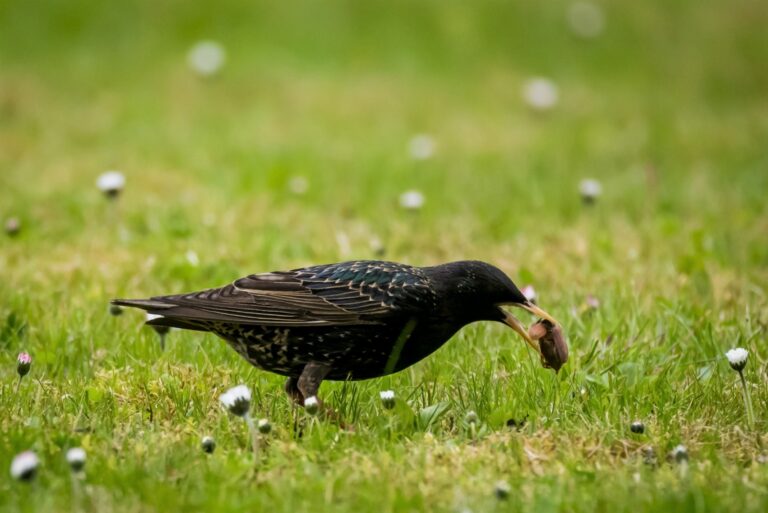
What Do Starlings Eat Out Of The Grass?
Starlings primarily forage on the ground in open areas, probing in soil and grass with their beaks.
Starlings are known to consume a varied diet including many types of bugs, larvae, seeds, corn, grains, and berries. However, they prefer catching insects, if available.
During summer, they prefer eating flies, caterpillars, beetles, spiders, snails, grasshoppers, earthworms, and other invertebrates.
In the fall and winter months, they will choose a wide variety of fruits in trees, berries, and seeds. At this time, they will often come to bird feeders as well.
Starlings often flock shortly after grass mowing as they are attracted to all the bugs and seeds that get exposed in the short, freshly cut grass. When you stir up the lawn with the lawnmower, it’s easier for these birds to reach the worms and insects that they’re after.
It is advised to be persistent in starling control and start working on controlling these obnoxious birds before they have gained a strong attraction to your yard. This way, you will be more successful in eradicating them.
Starlings are a very invasive species that require the help of a professional to get rid of them for good. So, contact Westchester Wildlife to learn more about our bird control services, which include bird proofing, removal, and trapping.
Our experienced technicians at Westchester Wildlife will humanely trap and remove the invading starlings from your property. We are servicing Westchester, Dutchess, and Putnam Counties in New York, as well as Fairfield County in Connecticut.
 Is It Normal For Coyotes To Come Out During The Day?
Is It Normal For Coyotes To Come Out During The Day?





















